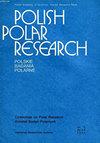斯瓦尔巴群岛海陆过渡地壳和上地幔的地球物理性质
IF 0.8
4区 地球科学
Q4 ECOLOGY
引用次数: 1
摘要
本文章由计算机程序翻译,如有差异,请以英文原文为准。
Geophysical properties of the crust and upper mantle of the ocean-continent transition in Svalbard area
This paper presents a review of geophysical studies of the crust and the lithosphereasthenosphere boundary (LAB) in the ocean-continent transition in the area of Spitsbergen (Svalbard Archipelago) in high Arctic. Over last decades many investigations were performed during Polish geophysical expeditions, as well as in the framework of international cooperation with scientists from Germany, Japan, Norway and USA. We compiled here existing seismic, gravity and thermal models down to LAB depth along the 800 km long transect extending from the actively spreading Knipovich Ridge, across southern Spitsbergen to the Kong Karls Land Volcanic Province. The results of all methods are very consistent, although they are sensitive to different physical parameters: seismic wave velocities, densities and thermal. The thinnest lithosphere of only 12 km is found beneath the Knipovich Ridge. Only 50 km to the west and 50 km to the east of the ridge the LAB depth increases to about 30 km, and this value corresponds to the oceanic structure of the North Atlantic Ocean. Beneath southern Spitsbergen the LAB depth is about 55 km and increases to 90–100 km beneath continental structure of the Barents Sea. The uplift of the LAB close to distance of 700 km along transect could be correlated with Kong Karls Land Volcanic Province.
求助全文
通过发布文献求助,成功后即可免费获取论文全文。
去求助
来源期刊

Polish Polar Research
ECOLOGY-GEOSCIENCES, MULTIDISCIPLINARY
CiteScore
2.00
自引率
7.70%
发文量
0
审稿时长
>12 weeks
期刊介绍:
The quarterly Polish Polar Research edited by the Committee on Polar Research of the Polish Academy of Sciences is an international journal publishing original research articles presenting the results of studies carried out in polar regions.
All papers are peer-reviewed and published in English.
The Editorial Advisory Board includes renowned scientist from Poland and from abroad.
 求助内容:
求助内容: 应助结果提醒方式:
应助结果提醒方式:


